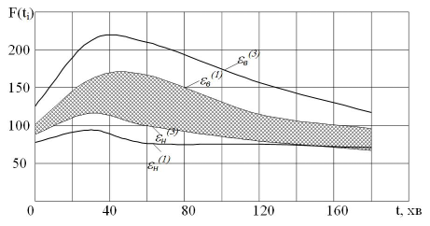Дослідження регресійних моделей динаміки глікемії в умовах вимірювальної невизначеності
Основний зміст сторінки статті
Анотація
У статті розглядається статистичне обґрунтування процедур ідентифікації параметрів моделі динаміки глікемії в умовах невизначеності результатів вимірювань. Обґрунтовано вибір регресійної моделі з випадковими коефіцієнтами, що характеризує зміни рівня глікемії при істотних обмеженнях на обсяг первинної вимірювальної інформації. Проаналізовані існуючі методи визначення діабету 2 типу, а також моделі для ідентифікації діабетичних станів. Визначені три моделі, яким слід надати перевагу при ідентифікації діабетичного стану. Також виявлено одну основну модель, яка найбільш прийнятна для задач розпізнавання параметричної моделі динаміки глікемії при перевірці справедливості статистичних гіпотез.
Блок інформації про статтю

Ця робота ліцензується відповідно до Creative Commons Attribution 4.0 International License.
Автори, які публікуються у цьому журналі, погоджуються з наступними умовами:- Автори залишають за собою право на авторство своєї роботи та передають журналу право першої публікації цієї роботи на умовах ліцензії Creative Commons Attribution License, котра дозволяє іншим особам вільно розповсюджувати опубліковану роботу з обов'язковим посиланням на авторів оригінальної роботи та першу публікацію роботи у цьому журналі.
- Автори мають право укладати самостійні додаткові угоди щодо неексклюзивного розповсюдження роботи у тому вигляді, в якому вона була опублікована цим журналом (наприклад, розміщувати роботу в електронному сховищі установи або публікувати у складі монографії), за умови збереження посилання на першу публікацію роботи у цьому журналі.
- Політика журналу дозволяє і заохочує розміщення авторами в мережі Інтернет (наприклад, у сховищах установ або на особистих веб-сайтах) рукопису роботи, як до подання цього рукопису до редакції, так і під час його редакційного опрацювання, оскільки це сприяє виникненню продуктивної наукової дискусії та позитивно позначається на оперативності та динаміці цитування опублікованої роботи (див. The Effect of Open Access).
Посилання
“Combo Glucometer (CoG)- Non-invasive Hybrid Glucometer.” [Online]. Available: https://cnogacare.co/products/cog-info/.
K. Laska, “Blood Sugar Monitoring: Using Infrared Instead of Invasive Techniques,” MEDICA-tradefair.com, URL: https://www.medica-tradefair.com/en/News/Interviews/Previous_Interviews/Interviews_2019/Blood_Sugar_Monitoring_Using_Infrared_Instead_of_Invasive_Techniques.
D. Muoio, “Study finds wearable heart rate monitors feasible for early detection of hypoglycemia,” Mobi Health News. [Online]. Available: https://www.mobihealthnews.com/content/study-finds-wearable-heart-rate-monitors-feasible-early-detection-hypoglycemia.
N. Dzhonson, Statistika i planirovaniye eksperimenta v tekhnike i nauke: Metody planirovaniya eksperimenta [Statistics and experimental design in engineering and science: Experimental design methods]. Moscow: Mir, 1981.
A. Tsanas, M. A. Little, and P. E. McSharry, “A Methodology for the Analysis of Medical Data,” in Handbook of Systems and Complexity in Health, New York, NY: Springer New York, 2013, pp. 113–125, URL: http://link.springer.com/10.1007/978-1-4614-4998-0_7. DOI: 10.1007/978-1-4614-4998-0_7
V. I. Yunkerov and S. G. Grigor’yev, Matematiko statisticheskaya obrabotka dannykh meditsinskikh issledovaniy [Mathematical and statistical processing of medical research data]. St. Petersburg: VMedA, 2002.
W. G. HOPKINS, S. W. MARSHALL, A. M. BATTERHAM, and J. HANIN, “Progressive Statistics for Studies in Sports Medicine and Exercise Science,” Med. Sci. Sport. Exerc., vol. 41, no. 1, pp. 3–13, Jan. 2009, PMID: 19092709. DOI: 10.1249/MSS.0b013e31818cb278.
V. N. Vapnik, Vosstanovleniye zavisimostey po empiricheskim dannym [ Dependency Recovery from Empirical Data]. Moscow: Glavnaya redaktsiya fiziko-matematicheskoy literatury izdatel’stva “Nauka,” 1979.
D. Serbii, Lineynyy regressionnyy analiz [Linear Regression Analysis]. Moscow: Mir, 1980.
. V. Smirnov, Kurs teorii ymorvinostey i matematicheskoy statistiki dlya tekhnicheskikh prilozheniy [Course on the theory of morphine and mathematical statistics for technical applications]. Moscow: Nauka. Glavnaya redaktsiya Fizmatliteratury, 1969.
J. S. Armstrong, “Illusions in regression analysis,” Int. J. Forecast., vol. 28, no. 3, pp. 689–694, Jul. 2012, DOI: 10.1016/j.ijforecast.2012.02.001.
P. F. Shchapov, Pidvyshchennya dostovirnosti kontrolyu i diahnostyky ob’yektiv v umovakh nevyznachennosti [Improving the reliability of control and diagnostics of objects under uncertainty]. Kharkiv: KHNADU, 2011.





